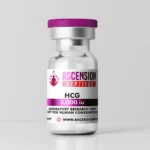Description
Human Chorionic Gonadotropin (HCG) represents a complex glycoprotein hormone naturally produced by the placenta during pregnancy, consisting of two non-covalently linked subunits designated alpha and beta. The compound exhibits the molecular formula C1105H1770N318O336S26 with a molecular weight of approximately 36,700 daltons and demonstrates structural homology with other glycoprotein hormones including luteinizing hormone (LH), follicle-stimulating hormone (FSH), and thyroid-stimulating hormone (TSH). The alpha subunit of HCG is identical to that found in LH, FSH, and TSH, consisting of 92 amino acids, while the beta subunit contains 145 amino acids and confers the hormone-specific biological activity and receptor binding characteristics.
The structural organization of HCG includes extensive glycosylation patterns that are critical for biological activity, receptor binding, and metabolic stability. The hormone contains four N-linked oligosaccharide chains and four O-linked oligosaccharide chains, with the carbohydrate content comprising approximately 30% of the total molecular weight. These glycosylation modifications are essential for proper protein folding, receptor recognition, and resistance to proteolytic degradation, contributing to the hormone’s extended half-life compared to other gonadotropins.
HCG functions primarily through high-affinity binding to the luteinizing hormone/choriogonadotropin receptor (LH/CG-R), a G-protein coupled receptor belonging to the rhodopsin-like receptor family. The receptor is predominantly expressed in gonadal tissues, including Leydig cells in the testes and theca cells and corpus luteum in the ovaries, as well as in various extragonadal tissues. Upon receptor binding, HCG activates the cyclic adenosine monophosphate (cAMP) signaling pathway through stimulation of adenylyl cyclase, leading to increased intracellular cAMP levels and activation of protein kinase A (PKA).
The mechanism of action involves conformational changes in the LH/CG receptor upon HCG binding, leading to activation of the associated Gs protein and subsequent stimulation of adenylyl cyclase. This results in elevated cAMP levels, which activate PKA and lead to phosphorylation of various downstream targets including the cAMP response element-binding protein (CREB). In gonadal tissues, this signaling cascade stimulates steroidogenesis through upregulation of steroidogenic enzymes and cholesterol transport proteins, particularly the steroidogenic acute regulatory (StAR) protein.
Research applications of HCG include investigation of gonadotropin receptor pharmacology, reproductive endocrinology mechanisms, and steroidogenesis pathways. The compound serves as a valuable tool for studying LH/CG receptor function, signal transduction mechanisms, and the molecular basis of gonadotropin action in various tissue systems. HCG research has contributed significantly to understanding reproductive hormone regulation, fertility mechanisms, and the role of gonadotropins in both reproductive and non-reproductive tissues.
The 5000 International Unit (IU) formulation provides standardized biological activity based on the First International Standard for Human Chorionic Gonadotropin established by the World Health Organization. This standardization ensures consistent potency and reproducible results across research applications. The International Unit system for HCG is based on biological activity rather than mass, reflecting the hormone’s complex structure and the importance of proper folding and glycosylation for biological function.
HCG demonstrates unique pharmacokinetic properties compared to other gonadotropins, with an extended half-life of approximately 24-36 hours due to its extensive glycosylation and resistance to metabolic degradation. This extended half-life makes HCG particularly valuable for research applications requiring sustained gonadotropin activity or investigation of long-term hormone effects on target tissues.
The compound’s research utility extends beyond reproductive endocrinology to include investigation of extragonadal HCG effects, including potential roles in angiogenesis, immune modulation, and cellular differentiation. Research has identified LH/CG receptors in various non-reproductive tissues, suggesting broader physiological roles for HCG beyond its classical reproductive functions.
Quality control and standardization of HCG research preparations involve multiple analytical methods including bioassays, immunoassays, and physicochemical characterization. The biological activity is typically determined using in vivo bioassays or receptor binding assays that measure the hormone’s ability to stimulate cAMP production in target cells. Purity assessment includes evaluation of protein content, glycosylation patterns, and absence of contaminating proteins or endotoxins.
Research preparations of HCG require careful handling and storage to maintain biological activity and structural integrity. The hormone is sensitive to temperature, pH, and proteolytic degradation, necessitating appropriate storage conditions and reconstitution procedures. Lyophilized preparations typically demonstrate enhanced stability compared to liquid formulations, allowing for extended storage periods when maintained under appropriate conditions.
The compound’s research applications include investigation of male reproductive physiology, particularly the role of gonadotropins in testosterone production and spermatogenesis. In female reproductive research, HCG serves as a model for studying luteal function, ovarian steroidogenesis, and the hormonal regulation of pregnancy maintenance. The hormone’s ability to mimic LH activity makes it valuable for investigating the molecular mechanisms underlying gonadotropin action and reproductive hormone regulation.
Advanced research applications include investigation of HCG receptor variants, signal transduction pathway modulation, and the development of selective receptor modulators. The compound serves as a reference standard for evaluating the activity of synthetic gonadotropin analogues and for studying structure-activity relationships in gonadotropin receptor pharmacology.
Research preparations typically require reconstitution with sterile water or appropriate buffer solutions to achieve desired concentrations for experimental applications. The reconstituted hormone should be used promptly or stored under appropriate conditions to maintain biological activity. Proper handling procedures are essential to prevent degradation and ensure reproducible experimental results.
Only logged in customers who have purchased this product may leave a review.


Reviews
There are no reviews yet.